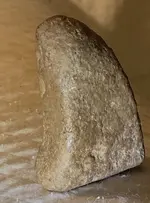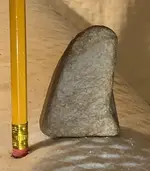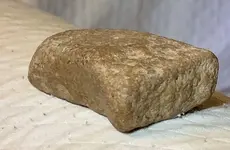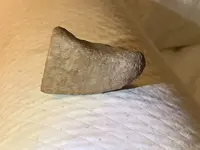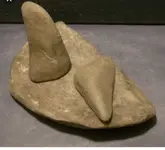You are using an out of date browser. It may not display this or other websites correctly.
You should upgrade or use an alternative browser.
You should upgrade or use an alternative browser.
How did they do this?
- Thread starter kyphote
- Start date
- Joined
- Mar 2, 2018
- Messages
- 7,222
- Reaction score
- 22,770
- Golden Thread
- 0
- Location
- Todds Point, IL
- Primary Interest:
- Metal Detecting
The way the narrow end is pecked it definitely looks like a tool. Maybe a knapping tool. Look at the pecked end with a magnifying glass and see if you see and specks of flint still embedded in it. Gary
DiggerKid2003
Sr. Member
- Joined
- Jul 5, 2014
- Messages
- 469
- Reaction score
- 1,103
- Golden Thread
- 0
- Location
- Spotsylvania VA
- Detector(s) used
- Garret At Pro, Garret Pro Pointer, Wireless Z-Lynk headphones.
- Primary Interest:
- Metal Detecting
If by "They" you mean mother nature, she works in mysterious ways. Seriously though, it is a natural rock IMO.
kyphote
Hero Member
- #6
Thread Owner
Sorry, by “they” I mean 100 percent Native Americans. That wasn’t the question. Maybe it requires holding or an understanding of the pile of artifacts it was pulled from. I was thinking tool, as well. But I’ve extracted nearly 100 tools, from this site – mostly scrapers, gravers, spokeshaves and hammerstones – and haven’t seen anything like it. I agree it seems unworked in appearance to be considered manufactured which is why I post. But the lines are too clean, the horn-like shape too uniform, and the base too sharply cut. Maybe suspend disbelief for a second and guess again? The nose shows use which isn’t clear in the pics.
IF a relic , it might simply be oil from skin acquired during use giving a finished (dipped) appearance.
A stone I use for a longtime doorstop has a waxy looking sheen it did not have originally.
The ends of your piece look used more than worked. Though used for work...
A stone I use for a longtime doorstop has a waxy looking sheen it did not have originally.
The ends of your piece look used more than worked. Though used for work...
justonemore
Sr. Member
Have suspended disbelief for at least six hours now and yep still seeing just a rock. The two bell pestles look iffy too. I don't doubt you have collected many artifacts from your site but not all rocks found on a site are artifacts. Mother nature over millions of years can do some amazing things to an environment.
Quartzite Keith
Full Member
- Joined
- Dec 17, 2018
- Messages
- 179
- Reaction score
- 408
- Golden Thread
- 0
- Primary Interest:
- All Treasure Hunting
In as far as how it's made, those telling you mother nature did it are correct. Both the shape and level of natural polish can be readily found in the quartzite gravels throughout central Virginia (and other areas with similar geologies). Keep in mind all the cobble/gravel quartzite here started life eons ago as quartzite outcrops on the mountain tops, which then fell down the mountains into rivers and tumbled around for a long time before being deposited and buried in the cobble and gravel beds. I have seen every kind of amazing shape imaginable and some very highly polished examples, especially from areas like here in Richmond where the pieces of stone get hung up in the granite rapids in the Fall Zone and tumble around and around.
That said, if it looks out of place, it may well have been brought there to be used as a tool. There is some pecking/wear on the small end. That could just mean that end was pointed upstream during a portion of the stone's life and got dinged up by passing gravel, or it may be use wear. The shape of the stone is very good for grinding small amounts of semi-soft material. There is that lovely natural thumb hold, and the flat end would fit nicely against the palm. Years ago when I was learning to make pine pitch glue I used a similar stone to grind up the charcoal that gets mixed in with the melted pitch. Your stone may well have been used in a similar fashion.
BTW, I did get your private message, and thank you for the kind words. If at any point you want another set of eyes to look at your site, let me know. As I said, I am in Richmond.
Keith
That said, if it looks out of place, it may well have been brought there to be used as a tool. There is some pecking/wear on the small end. That could just mean that end was pointed upstream during a portion of the stone's life and got dinged up by passing gravel, or it may be use wear. The shape of the stone is very good for grinding small amounts of semi-soft material. There is that lovely natural thumb hold, and the flat end would fit nicely against the palm. Years ago when I was learning to make pine pitch glue I used a similar stone to grind up the charcoal that gets mixed in with the melted pitch. Your stone may well have been used in a similar fashion.
BTW, I did get your private message, and thank you for the kind words. If at any point you want another set of eyes to look at your site, let me know. As I said, I am in Richmond.
Keith
kyphote
Hero Member
- #11
Thread Owner
Thank you all. Huge help. It's true the site is home to rocks with wild shapes and colors. Some I assume were hand picked for just those reasons. Maybe this one was brought to the site because it was already shaped like a pestle and didn't have to be worked. The base is maybe the most compelling and poorly depicted. It is coarse, not smooth like a rounded river rock. The rock was clearly -- and cleanly -- broken off at the base, yet the edges are rounded and the base is worn and the same color as the rest of the rock.
Thanks again. I'm glad for the mixed opinions because everyone here knows their stuff, and it gives me plenty to think about. Keith, I would love to connect.
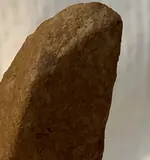
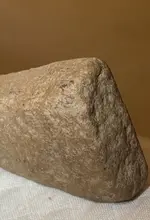
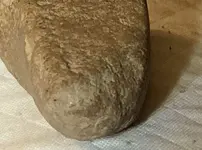
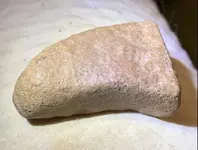
Thanks again. I'm glad for the mixed opinions because everyone here knows their stuff, and it gives me plenty to think about. Keith, I would love to connect.




Last edited:
unclemac
Gold Member
- Joined
- Oct 12, 2011
- Messages
- 7,433
- Reaction score
- 7,817
- Golden Thread
- 0
- Primary Interest:
- Beach & Shallow Water Hunting
it could easily be a natural shape that was utilized for some reason and so shows wear. does anyone here actually think native people took large round cobbles and pecked away at them to make thin pestles and such? no, they started with something already roughly the size and shape they needed.
Buckleberry
Hero Member
Natural
kyphote
Hero Member
- #14
Thread Owner
Natural
Again, this isn't something I tripped over in the parking lot. It was lumped alongside countless text book artifacts in a spot the size of my kitchen table. Add to that the fact I've been digging the place for 40 years, and it's not hard to distinguish native rocks from something brought in by Native Americans. It's how I discovered the spot to begin with. A rock -- way more ordinary than this -- that didn't line up with the other rocks in that 70 acre field.
With a few exceptions -- which I will continue to post -- it all becomes intuitive. That said, while I know what's NA at this spot and what's not, experts like you are far better equipped to provide ID, explain item functions, etc, etc. I appreciate the lessons learned already.
- Joined
- Dec 12, 2009
- Messages
- 2,817
- Reaction score
- 3,356
- Golden Thread
- 0
- Location
- St. Charles County, Missouri
- Detector(s) used
- Garrett AT Pro, Tesoro Vaquero, Bounty Hunter Land Star, Teknetics Delta 4000, Minelab Equinox 600, Garrett Carrot
- Primary Interest:
- All Treasure Hunting
Please post up some of your 'textbook' artifacts.
newnan man
Gold Member
- Joined
- Aug 8, 2005
- Messages
- 6,746
- Reaction score
- 26,110
- Golden Thread
- 0
- Location
- Beautiful Florida
- Primary Interest:
- Relic Hunting
Those are just rocks.
unclemac
Gold Member
- Joined
- Oct 12, 2011
- Messages
- 7,433
- Reaction score
- 7,817
- Golden Thread
- 0
- Primary Interest:
- Beach & Shallow Water Hunting
these are bell pestles
https://www.google.com/search?q=bel...AgEEAE&biw=1368&bih=770#imgrc=vNYSh1Fm5DkaDM:
https://www.google.com/search?q=bel...AgEEAE&biw=1368&bih=770#imgrc=vNYSh1Fm5DkaDM:
MAMucker
Bronze Member
- Joined
- Feb 2, 2019
- Messages
- 1,636
- Reaction score
- 2,980
- Golden Thread
- 0
- Location
- Massachusetts
- Primary Interest:
- Other
Ancient prosthetic nose
Similar threads
- Replies
- 8
- Views
- 377
- Suggestion
- Replies
- 5
- Views
- 785
- Replies
- 5
- Views
- 459
Users who are viewing this thread
Total: 1 (members: 0, guests: 1)

